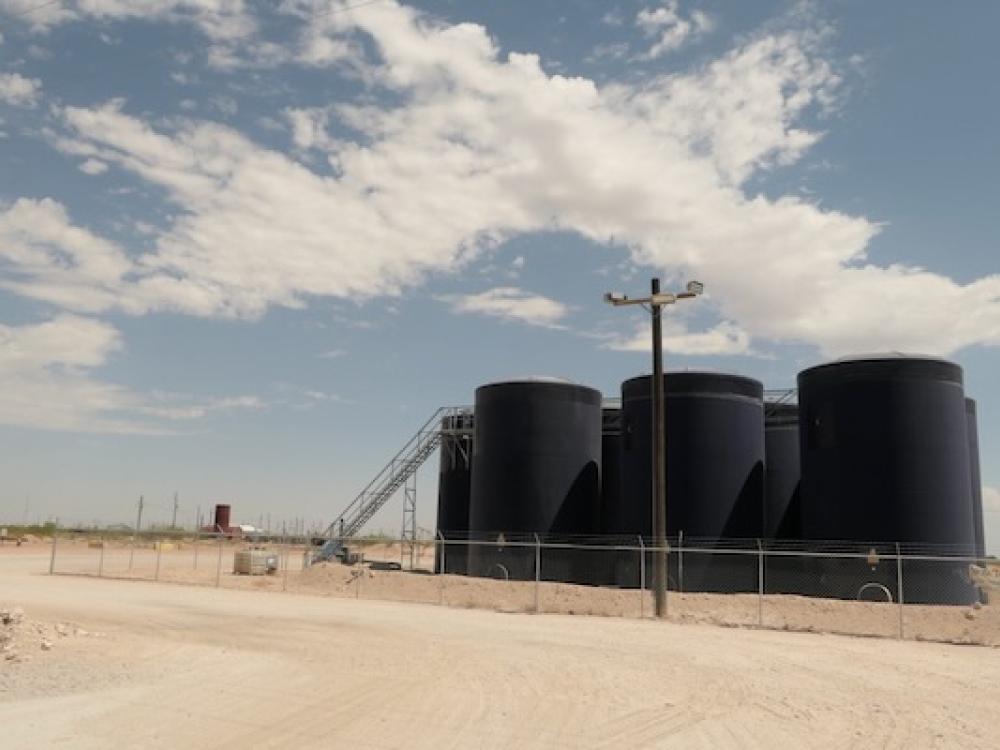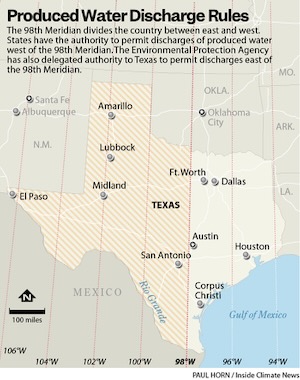
Produced water is stored in tanks outside Pecos, Texas, in August 2023. Disposing of billions of gallons of produced water is a growing challenge for the oil and gas industry in Texas. Photo by Martha Pskowski, Inside Climate News.
August 25, 2023
By Martha Pskowski, Inside Climate News
This article originally appeared on Inside Climate News, a nonprofit, independent news organization that covers climate, energy and the environment. It is republished with permission. Sign up for their newsletter here.
When a team of researchers at Texas A&M University-Corpus Christi combed through Railroad Commission records several years ago, they found more than 50 permits allowing conventional oil and gas drillers to discharge oil field wastewater, known as produced water, into creeks and streams near the Eagle Ford shale basin in South Texas.
Although produced water contains naturally occuring toxins such as ammonia and radionuclides and also sometimes toxic drilling chemicals, the permits relied on companies self-reporting the contents. In their 2021 paper, published in the Texas Water Journal, the researchers found the permits allowed 700,000 gallons annually of untreated oil field wastewater to be dumped into small creeks and tributaries that cattle drank from.
“I had concerns about what I saw in the field, about cattle drinking that water,” said Dorina Murgulet, a hydrogeologist and co-author on the paper.
While the health and environmental effects of these discharges have never been studied, Texas regulators are moving forward to allow more discharges of oil field wastewater from conventional drilling and fracking into bodies of water before what scientists consider a thorough risk assessment is completed.
The greatest volumes of produced water are in the Permian Basin, where oil and gas drilling creates billions of barrels of produced water every year. The water comes back to the surface laced with both natural contaminants and chemical additives from drilling fluids. In arid West Texas, streams and rivers could become disposal sites for treated produced water.
At an industry conference in Midland this March, Texas Commission on Environmental Quality Commissioner Emily Lindley encouraged oil and gas companies to apply for discharge permits. “I just want to encourage you to come get a permit from us,” Lindley said. “If you think you want to discharge your water to the state, we’re ready to take those permits. Let’s do it.”
The state is eager to move forward on this largely unproven practice. While studies are ongoing, a 2022 research paper by scientists at New Mexico State University and the University of Texas at El Paso found that Permian Basin produced water samples contained everything from per- and polyfluoroalkyl substances — a group of chemicals known as PFAS that break down very slowly in the environment — to naturally occurring radioactive material. However, Texas water quality standards do not cover numerous constituents the scientists found in Permian Basin produced water. This means state regulators do not have toxicity data to evaluate the chemicals’ potential health risks to humans or standard methods to detect them in produced water before it’s discharged into waterways.
A TCEQ spokesperson said applications to discharge produced water in West Texas will be considered on a “case-by-case basis” in accordance with existing water quality standards and the receiving body of water.
Environmental advocates say the TCEQ is being too hasty.
“It’s economically unproven and technologically unproven, and we have had no risk assessment done,” said Alex Ortiz, a water resources specialist at the Lone Star Sierra Club. “That concerns me.”
Texas Granted Authority to Permit Discharges of Produced Water
 Graphic by Inside Climate News.
Graphic by Inside Climate News.
Since hydraulic fracturing, or fracking, took off in Texas, the volume and toxicity of produced water has multiplied. In the fracking process, operators inject water, sand and chemicals underground to dislodge oil or gas. In Texas, an average of seven barrels of water is now produced for every one barrel of oil. A recent report by the Texas Produced Water Consortium estimated that, as of 2019, production in the Texas Permian Basin alone was generating 3.9 billion barrels, or over 168 billion gallons, of produced water a year.
Operators inject most of the water back underground in deep disposal wells. But after a spate of earthquakes was linked to the wells, operators and regulators are seeking new disposal methods.
Federal law allows produced water to be discharged to waterways west of the 98th Meridian, a line that roughly divides the arid West and the water-rich East, if it is beneficial to agriculture or wildlife. East of the 98th Meridian, including Austin and points east, the water must first pass through a central waste treatment facility.
The TCEQ additionally sought authority, or primacy, from the Environmental Protection Agency to permit produced water discharges statewide. EPA granted the request in 2021, and this May, the TCEQ released its draft permit covering discharges east of the 98th Meridian. The permit will authorize discharges of produced water from stripper wells — marginal wells with low production levels — to inland rivers and streams east of the 98th Meridian. The permit also authorizes discharges from both fracking sites and conventional drilling off the Texas coast into the Gulf of Mexico.
The TCEQ has not elaborated on how the agency will judge applications to discharge produced water from hydraulic fracturing west of the 98th Meridian, which includes the Permian Basin. An agency spokesperson acknowledged that some constituents in produced water are unregulated but said that when the EPA introduces standards for these constituents, the TCEQ will incorporate them. For some constituents, like PFAS, the EPA is in the process of developing new standards. But for others, there is no established time frame. In the meantime, the agency is poised to issue permits to discharge these little-known chemicals into bodies of water.
Environmental Defense Fund senior scientist Cloelle Danforth and oil and gas attorney Nichole Saunders took issue with TCEQ’s approach in their comments on the draft permit. They called on the TCEQ to broaden the scope of chemical constituents covered by the permit and require operators to conduct more testing on produced water.
As for the permits the Railroad Commission issued for produced water discharges, a TCEQ spokesperson said approximately 100 were transferred to that agency since it received primacy for produced water discharges.
Murgulet, the TAMU-CC hydrogeologist who co-authored the 2021 paper on the Railroad Commission permits, said groundwater districts had not been informed of the discharges authorized by the agency. She said she would like to see an independent third-party study of the produced water to verify whether the companies accurately reported its constituents.
 Railroad Commission of Texas (RRC) and Texas Commission on Environmental Quality (TCEQ) district offices occupy the same office building in Midland, Texas. The TCEQ now oversees permitting for produced water discharges in Texas. Photo by Martha Pskowski, Inside Climate News.
Railroad Commission of Texas (RRC) and Texas Commission on Environmental Quality (TCEQ) district offices occupy the same office building in Midland, Texas. The TCEQ now oversees permitting for produced water discharges in Texas. Photo by Martha Pskowski, Inside Climate News.
Potential Fracking Wastewater Discharges in Arid West Texas Raise Concerns
The Pecos River flows southeast from the Sangre de Cristo Mountains in Northern New Mexico before crossing into Texas and eventually flowing into the Amistad Reservoir at the Rio Grande. Invasive species, agriculture, the oil and gas industry and drought have all taken a toll on the river. From the crystalline headwaters, the river’s flow dwindles through the Permian Basin, where the water has high levels of salt and toxic dissolved solids. That includes dissolved matter in water, like minerals, salts and organic matter.
Because of the river’s proximity to oil and gas drilling in a water-stressed region, it is now considered by some scientists and industry representatives to be a prime candidate for produced water discharges. But significant obstacles remain.
The Pecos River in Texas is already classified as “impaired” by pollution under the Clean Water Act. However, the TCEQ does not have an active management plan to improve water quality for the Lower or Upper Pecos segments, according to agency records.
 The Pecos River runs from New Mexico through the Texas Permian Basin. In Reeves County in August 2023, the riverbed was mostly dry following a summer of high temperatures and little rainfall. The Pecos River has been discussed for produced water discharges. Photo by Martha Pskowski, Inside Climate News.
The Pecos River runs from New Mexico through the Texas Permian Basin. In Reeves County in August 2023, the riverbed was mostly dry following a summer of high temperatures and little rainfall. The Pecos River has been discussed for produced water discharges. Photo by Martha Pskowski, Inside Climate News.
Produced water should be diluted with freshwater to mitigate the effects of toxins. But researchers at the University of Texas at Austin’s Bureau of Economic Geology pointed out in a presentation that because the flow of the Pecos River is so low in some places, the produced water would barely be diluted. They posited that during some periods produced water would “greatly exceed” freshwater flow on the river.
NMSU and UTEP researchers analyzed produced water samples from the Permian Basin and water samples from the Pecos River. They detected volatile and semivolatile organic compounds, radionuclides, ammonia, hydraulic fracturing additives, PFAS and naturally occurring radioactive material in the produced water.
Radionuclides, which include radium and uranium, have been linked to tumors and lung cancer in humans, according to the EPA. PFAS are a group of manufactured chemicals that scientific studies have found can increase risk of some cancers and lead to decreased fertility in women, among other health impacts.
Researchers also found that the levels of toxic dissolved solids in the produced water are more than 200 times the EPA’s limit for drinking water. Treating water with such high TDS levels would require expensive techniques.
NMSU civil engineering professor and co-author Pei Xu said the study was the first step to understand the makeup of Permian Basin produced water and how to treat it. “We’re looking at the holistic approach to make sure that if we treat the produced water, we are able to minimize the risks that could be related to the environment, to public health, to aquatic microorganisms,” Xu said.
EDF’s Danforth is concerned that produced water discharges would include chemical constituents that could harm human or ecological health. In a 2020 journal article, Danforth and co-authors at Texas A&M University and the Endocrine Disruption Exchange in Colorado found that 86 percent of produced water chemicals lack toxicity data to complete a risk assessment.
Permits for produced water discharges must meet existing state and federal water quality standards. But “only a small fraction” of the 1,300 chemicals that have been found in produced water, which include hydraulic fracturing chemicals, are covered by existing state and federal regulatory standards, according to EDF data.
An exemption known as the “Halliburton loophole,” which was inserted into the national Energy Policy Act in 2005, allows industry to use chemicals in oil and gas fracking that would otherwise be regulated under the federal Safe Drinking Water Act. The exemption was nicknamed for the Houston-based oil field services company Halliburton because of the perception that former Vice President Dick Cheney, who was CEO of Halliburton before he took office, advocated for it.
Texas is among 23 states that require industry to disclose chemicals used in fracking to FracFocus, an industry-backed chemical database, but oil and gas companies do not have to publicly disclose those which it considers proprietary.
“We just don’t know enough,” Danforth said in an interview. “The tools that we have to characterize both the chemical constituents and the toxicological character of produced water are lacking, which then hinders our ability to write protective permits.”
The Sierra Club’s Ortiz said some states like New Mexico or California might supplement the federal standards to create a more protective permitting program. “But that is clearly not true in a state like Texas that takes those federal regulatory minimums and runs with them,” Ortiz said.
NMSU’s Xu is optimistic that produced water can be treated to meet current water quality standards. But she acknowledged that those standards will continue to change. “Safe is an evolving term,” Xu said.
“How can we best employ the tools that we do have?” Danforth said regulators should be asking. “What sort of risk are we potentially creating?”
Texas Plows Ahead of Scientific Research
Texas isn’t the first state to explore disposing of produced water in rivers. As fracking took off in the Marcellus Shale around 2008, Pennsylvania companies began sending produced water to central wastewater treatment plants that discharge into rivers.
But within just a few years, Pennsylvania regulators asked companies to stop. Even after treatment, high levels of toxic dissolved solids persisted in the water, gumming up the treatment systems and causing unknown damage downstream.
Pennsylvania State University environmental engineer William Burgos and other researchers found elevated levels of salt and radioactive chemicals likely linked to the Marcellus Shale formation when they tested sediments from a reservoir more than 6 miles downstream of discharge points. Other researchers found elevated concentrations of strontium, a constituent of oil and gas wastewater, in the shells of freshwater mussels downstream from wastewater disposal sites.
“We saw that a centralized wastewater treatment plant can have watershed-scale effects on downstream activity,” Burgos said.
With Texas, New Mexico and Colorado all exploring surface water discharges, scientists like Xu at NMSU say more research is still needed. Each of these states has formed a Produced Water Consortium, where researchers, industry representatives and environmental advocates study disposal options.
NMSU’s Xu is research director of the New Mexico Produced Water Consortium, which is directly informing the New Mexico Environment Department. “The goal is to provide the information and the data for NMED to make science-based regulations on produced water treatment and reuse outside of the oil and gas field,” she said.
Unlike Texas, New Mexico is waiting to apply for primacy from the EPA until the consortia produces more scientific data. In Texas, Gov. Greg Abbott signed a state budget in June that included $5 million in funding for the Texas Produced Water Consortium over the next two years. The consortium will report back to the Legislature in October 2024.
In a written statement, consortium Director Rusty Smith said it is establishing pilot projects to treat produced water in “closed loop” settings to understand its characteristics in the Permian Basin. He said these studies would help “determine the viability of using produced water outside the oil and gas industry.”
Smith said the consortium works closely with federal and state regulators.
A TCEQ spokesperson said the agency participates in the consortium and will review its reports and incorporate the findings into permitting programs “as determined appropriate.”
But comments by Lindley, the TCEQ commissioner, in March indicated regulators are intent on moving forward with produced water discharges. “We’ve got the program up and running,” she said at the Water in Energy Conference in Midland, which is sponsored by companies including ExxonMobil subsidiary XTO Energy.
“I’m not going to say it’s going to be a cakewalk to get a permit from us and be able to discharge it,” Lindley said. “But don’t get so held up on, ‘We can’t discharge it until we know a number.’ Come talk to us and let’s get there. Let’s figure it out.”
But advocates say Texas is not yet ready to safely implement the practice.
The Sierra Club’s Ortiz acknowledged that in a water-stressed state like Texas, treating produced water for discharge is a tantalizing possibility despite the challenges.
“People want to know, if not now, when can it happen? When can we treat it to the point of discharge for whatever purposes?” Ortiz said. “Unfortunately, the answer is no one knows.”
Correction: An earlier version of this article incorrectly referred to 1,300 chemicals used in hydraulic fracturing, most of which are not covered by existing state and federal regulatory standards. Those 1,300 chemicals have been found in produced water and include hydraulic fracturing chemicals.
Stay up to date on everything green in North Texas, including the latest news and events! Sign up for the weekly Green Source DFW Newsletter! Follow us on Facebook,Twitter and Instagram. Also check out our podcast The Texas Green Report, available on your favorite podcast app.









